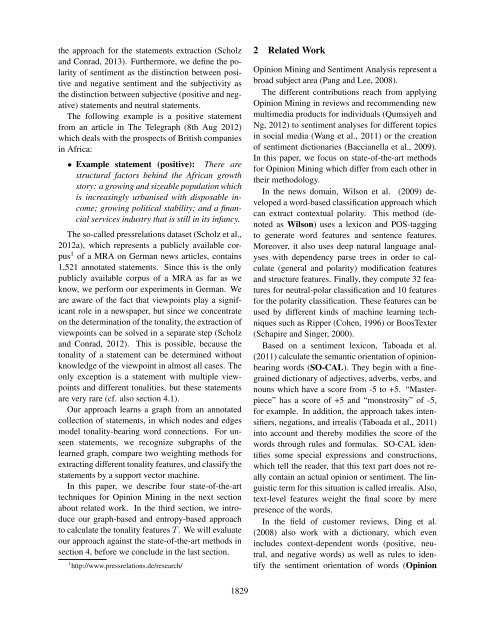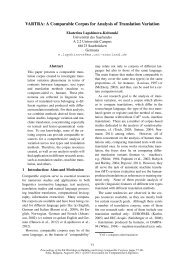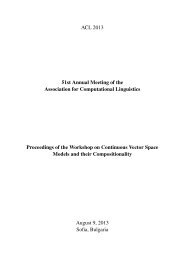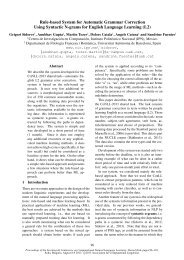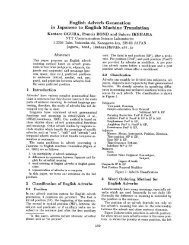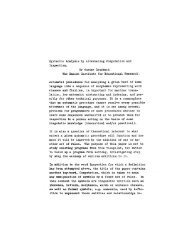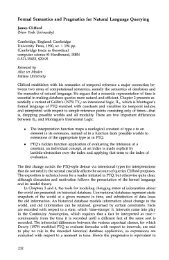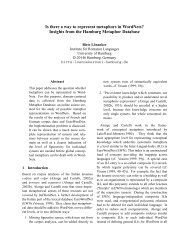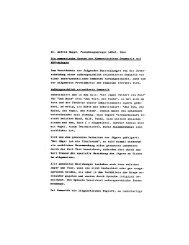Opinion Mining in Newspaper Articles by Entropy-Based Word ...
Opinion Mining in Newspaper Articles by Entropy-Based Word ...
Opinion Mining in Newspaper Articles by Entropy-Based Word ...
You also want an ePaper? Increase the reach of your titles
YUMPU automatically turns print PDFs into web optimized ePapers that Google loves.
the approach for the statements extraction (Scholz<br />
and Conrad, 2013). Furthermore, we def<strong>in</strong>e the polarity<br />
of sentiment as the dist<strong>in</strong>ction between positive<br />
and negative sentiment and the subjectivity as<br />
the dist<strong>in</strong>ction between subjective (positive and negative)<br />
statements and neutral statements.<br />
The follow<strong>in</strong>g example is a positive statement<br />
from an article <strong>in</strong> The Telegraph (8th Aug 2012)<br />
which deals with the prospects of British companies<br />
<strong>in</strong> Africa:<br />
• Example statement (positive): There are<br />
structural factors beh<strong>in</strong>d the African growth<br />
story: a grow<strong>in</strong>g and sizeable population which<br />
is <strong>in</strong>creas<strong>in</strong>gly urbanised with disposable <strong>in</strong>come;<br />
grow<strong>in</strong>g political stability; and a f<strong>in</strong>ancial<br />
services <strong>in</strong>dustry that is still <strong>in</strong> its <strong>in</strong>fancy.<br />
The so-called pressrelations dataset (Scholz et al.,<br />
2012a), which represents a publicly available corpus<br />
1 of a MRA on German news articles, conta<strong>in</strong>s<br />
1,521 annotated statements. S<strong>in</strong>ce this is the only<br />
publicly available corpus of a MRA as far as we<br />
know, we perform our experiments <strong>in</strong> German. We<br />
are aware of the fact that viewpo<strong>in</strong>ts play a significant<br />
role <strong>in</strong> a newspaper, but s<strong>in</strong>ce we concentrate<br />
on the determ<strong>in</strong>ation of the tonality, the extraction of<br />
viewpo<strong>in</strong>ts can be solved <strong>in</strong> a separate step (Scholz<br />
and Conrad, 2012). This is possible, because the<br />
tonality of a statement can be determ<strong>in</strong>ed without<br />
knowledge of the viewpo<strong>in</strong>t <strong>in</strong> almost all cases. The<br />
only exception is a statement with multiple viewpo<strong>in</strong>ts<br />
and different tonalities, but these statements<br />
are very rare (cf. also section 4.1).<br />
Our approach learns a graph from an annotated<br />
collection of statements, <strong>in</strong> which nodes and edges<br />
model tonality-bear<strong>in</strong>g word connections. For unseen<br />
statements, we recognize subgraphs of the<br />
learned graph, compare two weight<strong>in</strong>g methods for<br />
extract<strong>in</strong>g different tonality features, and classify the<br />
statements <strong>by</strong> a support vector mach<strong>in</strong>e.<br />
In this paper, we describe four state-of-the-art<br />
techniques for <strong>Op<strong>in</strong>ion</strong> <strong>M<strong>in</strong><strong>in</strong>g</strong> <strong>in</strong> the next section<br />
about related work. In the third section, we <strong>in</strong>troduce<br />
our graph-based and entropy-based approach<br />
to calculate the tonality features T . We will evaluate<br />
our approach aga<strong>in</strong>st the state-of-the-art methods <strong>in</strong><br />
section 4, before we conclude <strong>in</strong> the last section.<br />
1 http://www.pressrelations.de/research/<br />
2 Related Work<br />
<strong>Op<strong>in</strong>ion</strong> <strong>M<strong>in</strong><strong>in</strong>g</strong> and Sentiment Analysis represent a<br />
broad subject area (Pang and Lee, 2008).<br />
The different contributions reach from apply<strong>in</strong>g<br />
<strong>Op<strong>in</strong>ion</strong> <strong>M<strong>in</strong><strong>in</strong>g</strong> <strong>in</strong> reviews and recommend<strong>in</strong>g new<br />
multimedia products for <strong>in</strong>dividuals (Qumsiyeh and<br />
Ng, 2012) to sentiment analyses for different topics<br />
<strong>in</strong> social media (Wang et al., 2011) or the creation<br />
of sentiment dictionaries (Baccianella et al., 2009).<br />
In this paper, we focus on state-of-the-art methods<br />
for <strong>Op<strong>in</strong>ion</strong> <strong>M<strong>in</strong><strong>in</strong>g</strong> which differ from each other <strong>in</strong><br />
their methodology.<br />
In the news doma<strong>in</strong>, Wilson et al. (2009) developed<br />
a word-based classification approach which<br />
can extract contextual polarity. This method (denoted<br />
as Wilson) uses a lexicon and POS-tagg<strong>in</strong>g<br />
to generate word features and sentence features.<br />
Moreover, it also uses deep natural language analyses<br />
with dependency parse trees <strong>in</strong> order to calculate<br />
(general and polarity) modification features<br />
and structure features. F<strong>in</strong>ally, they compute 32 features<br />
for neutral-polar classification and 10 features<br />
for the polarity classification. These features can be<br />
used <strong>by</strong> different k<strong>in</strong>ds of mach<strong>in</strong>e learn<strong>in</strong>g techniques<br />
such as Ripper (Cohen, 1996) or BoosTexter<br />
(Schapire and S<strong>in</strong>ger, 2000).<br />
<strong>Based</strong> on a sentiment lexicon, Taboada et al.<br />
(2011) calculate the semantic orientation of op<strong>in</strong>ionbear<strong>in</strong>g<br />
words (SO-CAL). They beg<strong>in</strong> with a f<strong>in</strong>egra<strong>in</strong>ed<br />
dictionary of adjectives, adverbs, verbs, and<br />
nouns which have a score from -5 to +5. “Masterpiece”<br />
has a score of +5 and “monstrosity” of -5,<br />
for example. In addition, the approach takes <strong>in</strong>tensifiers,<br />
negations, and irrealis (Taboada et al., 2011)<br />
<strong>in</strong>to account and there<strong>by</strong> modifies the score of the<br />
words through rules and formulas. SO-CAL identifies<br />
some special expressions and constructions,<br />
which tell the reader, that this text part does not really<br />
conta<strong>in</strong> an actual op<strong>in</strong>ion or sentiment. The l<strong>in</strong>guistic<br />
term for this situation is called irrealis. Also,<br />
text-level features weight the f<strong>in</strong>al score <strong>by</strong> mere<br />
presence of the words.<br />
In the field of customer reviews, D<strong>in</strong>g et al.<br />
(2008) also work with a dictionary, which even<br />
<strong>in</strong>cludes context-dependent words (positive, neutral,<br />
and negative words) as well as rules to identify<br />
the sentiment orientation of words (<strong>Op<strong>in</strong>ion</strong><br />
1829


